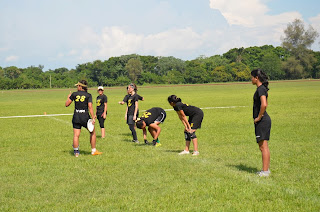Tomado de ULTIMATE ROB
http://www.ultimaterob.com/2013/02/13/reading-between-the-lines/
Whether you’re a player, a captain or a coach, you will have invariably dealt with lines – either being called or calling them.
I think there are 4 scenarios for calling lines which depend on the type of game you’re playing:
- If you are playing a team that is either stronger or weaker than you, I think it’s a good idea to call positions and rotate among lines.
- If you are playing an evenly matched team and you will end up trading points most of the game, I think it’s a good idea to call O and D lines.
- You can take a hybrid approach but always be aware and adjust accordingly.
- Upwind/downwind lines
Scenario #1: Uneven teams, not trading points
Scenario #2: Evenly matched teams, trading points
Generally the more competitive, advanced teams will run O and D lines and this can be useful in a tight game that is back and forth. By having a dedicated O line, you can put more players on your D line, keep the fresh legs going to help wear out their O line and in a game of possession, try to build your O line to be as high percentage as possible. You will want to keep the O line small – 8-9 players I would recommend and have the rest on the D line. Your O line should be players who will make the high percentage throws, won’t drop little throws and will have patience to work the disc up the field if necessary. Your O line should score everytime they’re on the field as a general goal to aim for. Obviously this isn’t always the case, but it will help you structure your O line to be as close to that goal as possible. You want to have some good throwers, some good mids and some good deeps. Everyone else will be on the D line. The point of D is to force a turnover and then score so you’ll also need good throwers/mids and deeps on D. I was a D line player because I could pull, I was good at marking the thrower/mid/deep and I was a good thrower.Scenario #3: A mix of Scenarios #1 and #2
If the game is a mix of back and forth and a lot of points being scored in a row, then you will need to have the foresight and the flexibility to adjust. If you don’t, then you will get in situations where the other team goes on runs simply because you have the wrong personnel on the field. For example, if the other team scores and you then send out your O line, which proceeds to turn over and get scored on. So you leave your O line out for the next point and they again turn the disc over and get scored on…and so it goes. You need to give them maybe 2 chances and then change up the lines. Throw the D line on for a point.Scenario #4: Upwind/downwind lines
Many times the difference between winning and losing comes down to who can score upwind. Being able to control the disc, maintain possession and work the disc up the field upwind is a skill that can help your team win or lose games. In order to make upwind and downwind lines, it’s important to have throwers on the field who can work the disc up the field but also put up a throw into the wind when they have a receiver open. Not every handler has the ability to throw upwind – it requires putting a lot of spin on the disc, throwing at the right angle and having the consistency on your throw to put the disc where your receivers can get it. As someone who can throw upwind, I was always on the upwind line – I like being called on to be that guy but I also was grateful when I had guys on my line who had the ability to catch and throw upwind. It’s a skill that comes from a lot of practice. If you don’t know how much skill it takes yet, you’re probably not on the upwind line…There are multiple approaches to running lines. Some captains/coaches with in pod systems. Some teams will sit a group of different players every game and have those players instead be sideline players – talking to the onfield players, recognizing what O/D the other team is playing, etc…
How do you approach calling lines?

















0 comentarios:
Publicar un comentario